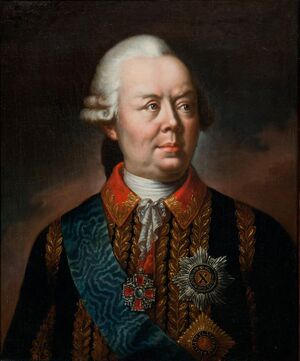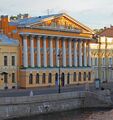پيوتر روميانتسيف
Count Pyotr Rumyantsev Zadunaisky | |
|---|---|
 | |
| General Governor of Little Russia Little Russian Collegium Chair | |
| في المنصب 1764–1786 | |
| العاهل | يكاترينا الكبرى |
| سبقه | office revived (replacing the Hetman of Zaporizhian Host Kyrylo Rozumovsky) |
| خلـَفه | office liquidated (himself as General Governor of Kiev, Chernigov, Novgorod-Seversky) |
| General Governor of Kursk Namestnichestvo | |
| في المنصب 1779–1781 | |
| العاهل | Catherine the Great |
| سبقه | office created |
| خلـَفه | Alexander Prozorovsky |
| General Governor of Kiev, Chernigov, and Novgorod-Seversky Namestnichestvos | |
| في المنصب 1782–1796 | |
| العاهل | Catherine the Great (1782–1796), Paul I (1796) |
| النائب | Mikhail Krechetnikov (1791–1793), Iosif Igelström (1793–1794) |
| سبقه | office created |
| خلـَفه | office liquidated |
| تفاصيل شخصية | |
| وُلِد | Pyotr Alexandrovich Rumyantsev-Zadunaisky 15 يناير 1725 Stroiești,[1] Russian Empire or Moscow,[2][3] Russian Empire |
| توفي | 19 ديسمبر 1796 (aged 71) Tashan, Pereyaslavsky Uyezd, Poltava Governorate, Russian Empire |
| الخدمة العسكرية | |
| الولاء | |
| الفرع/الخدمة | Imperial Russian Army |
| الرتبة | Field Marshal |
| المعارك/الحروب | War of the Austrian Succession Russo-Swedish War (1741–43) Pomeranian War Russo-Turkish War (1768–74) Russo-Turkish War (1787–92) |
Count Pyotr Alexandrovich Rumyantsev-Zadunaisky (روسية: Пётр Алекса́ндрович Румя́нцев-Задуна́йский;[أ] 15 January [ن.ق. 4 January] 1725 – 19 December [ن.ق. 8 December] 1796) was one of the foremost Russian generals of the 18th century. He was also one of the best military commanders in universal history between 1618 and 1905.[4] He governed Little Russia[5] in the name of Empress Catherine the Great from the abolition of the Cossack Hetmanate in 1764 until Catherine's death 32 years later. Monuments to his victories include the Kagul Obelisk in Tsarskoye Selo (1772), the Rumyantsev Obelisk on Vasilievsky Island (1798–1801), and a galaxy of Derzhavin's odes.
Early life
Pyotr was born into the noble Rumyantsev family. He was the only son of Count Alexander Rumyantsev, and probably born on the territory of modern Moldova in the village of Stroiești,[1][6] by Maria, the daughter and heiress of Count Andrey Matveyev. According to other versions, he was born in Moscow, and the Moldovan version of the birth is called legendary.[2][3] As his mother spent much time in the company of Peter the Great, rumours suggested that the young Rumyantsev was the monarch's illegitimate son. He was named after the ruling Emperor who was his godfather. He was the brother of Praskovya Bruce, confidant of Catherine the Great.
Pyotr Alexandrovich first saw military service under his nominal father in the war with Sweden (1741–1743). He personally carried to the Empress the peace treaty of Åbo, concluded by his father in 1743. Thereupon he gained promotion to the rank of colonel.
His first military glory dates from the great battles of the Seven Years' War (1756–1763), those of Gross-Jägersdorf (1757) and Kunersdorf (1759). In 1761 he besieged and took the Pomeranian fortress of Kolberg,[7][8] thus clearing for Russian armies the path to Berlin.
First Russo-Turkish War

Throughout the reign of Catherine the Great, Rumyantsev served as supreme governor of Little Russia. In this post, which his father had held with so much honesty, Rumyantsev made it his priority to eliminate any autonomy of the hetmans and to fully incorporate the newly conquered territories into the Russian Empire. Some accuse him of having promoted serfdom in New Russia, but the choice of such a policy remained out of his control.
With the outbreak of the Russo-Turkish war in 1768, Rumyantsev took command of the army sent to capture Azov. He thoroughly defeated the Turks in the battles of Stănilești, Larga, and Kagul, crossed the Danube and advanced to Romania. For these dazzling victories he became Field-Marshal and gained the victory title Zadunaisky (meaning "Trans-Danubian"). When his forces approached Shumla in 1774, the new Sultan Abdul Hamid I started to panic and sued for peace, which Rumyanstev signed upon a military tambourine at the village of Küçük Kaynarca.
Second Russo-Turkish War
By that point, Rumyantsev had undoubtedly become the most famous Russian commander. Other Catharinian generals, notably Potemkin, allegedly regarded his fame with such jealousy that they wouldn't permit him to take the command again. In times of peace, Rumyantsev expressed his innovative views on the martial art in the Instructions (1761), Customs of Military Service (1770), and the Thoughts (1777). These works provided a theoretical base for the re-organisation of the Russian army undertaken by Potemkin.
During the Second Russo-Turkish War, Rumyantsev suspected Potemkin of deliberately curtailing supplies of his army and presently resigned his command. In the Polish campaign of 1794 he once again won appointment as commander-in-chief, but his rival Suvorov actually led the armies into battle. On this occasion Rumyantsev didn't bother even to leave his Ukrainian manor at Tashan which he had rebuilt into a fortress. He died there on 19 December 1796, just over a month after Catherine's death, and was interred in the Kiev Pechersk Lavra.
As the story goes, old Rumyantsev-Zadunaisky grew enormously fat and avaricious, so that he pretended not to recognize his own sons when they came from the capital to ask for money. Under his son Sergey's administration, Tashan fell into ruins, although he erected a mausoleum near Balashikha for his father's reburial (which never took place). Neither Sergey nor his brother Nikolay Petrovich Rumyantsev married, and the comital branch of the Rumyantsev family became extinct upon their death.
Gallery
Portrait of Field Marshal Pyotr Rumyantsev-Zadunaisky. The portrait shows Rumyantsev in a fieldmarshal's uniform with gold embroidery on the collar, sides, and sleeves. Ribbons of the Orders of St. Andrew and St. George 1st Class are worn over the caftan. On the chest of the Field Marshal are embroidered stars of these awards. Unknown artist of the late 18th century
Kachanivka Palace, Ukraine
Nikolai Rumyantsev's mansion on English Quay, St. Petersburg
Government offices
| مناصب حكومية | ||
|---|---|---|
| سبقه Kyrylo Rozumovsky بصفته Hetman of Zaporizhian Host |
Governor-General of Little Russia 1764–1781 |
تبعه himself بصفته General Governor of Kiev, Chernigov and Novgorod-Siversky |
| سبقه himself بصفته General Governor of Little Russia |
General Governor of Kiev, Chernigov, Novgorod-Siversky 1782–1796 |
تبعه Sergey Vyazmitinov بصفته General Governor of Little Russia (Kamenets-Podolsky) |
| تبعه Ivan Saltykov بصفته General Governor of Kiev | ||
خطأ لوا في وحدة:Authority_control على السطر 278: attempt to call field '_showMessage' (a nil value).
See also
Notes
- ^ Pre-1918 orthography: Петръ Александровичъ Румянцевъ-Задунайскій
References
- ^ أ ب Vartichan & Andrunakievich (1982), p. 535
- ^ أ ب Korobkov 1947, p. 5.
- ^ أ ب Meerovich 1987, p. 8.
- ^ Bodart 1908, p. 789.
- ^
 Bain, Robert Nisbet (1911). . In Chisholm, Hugh (ed.). دائرة المعارف البريطانية. Vol. 3 (eleventh ed.). Cambridge University Press. p. 840.
Bain, Robert Nisbet (1911). . In Chisholm, Hugh (ed.). دائرة المعارف البريطانية. Vol. 3 (eleventh ed.). Cambridge University Press. p. 840. {{cite encyclopedia}}: Cite has empty unknown parameter:|coauthors=(help) - ^ "На территории Бендерской крепости открыли бюст русского полководца Петра Румянцева-Задунайского". Archived from the original on 2013-10-05. Retrieved 2010-07-02.
- ^
 Bain, Robert Nisbet (1911). . In Chisholm, Hugh (ed.). دائرة المعارف البريطانية. Vol. 9 (eleventh ed.). Cambridge University Press. p. 285.
Bain, Robert Nisbet (1911). . In Chisholm, Hugh (ed.). دائرة المعارف البريطانية. Vol. 9 (eleventh ed.). Cambridge University Press. p. 285. {{cite encyclopedia}}: Cite has empty unknown parameter:|coauthors=(help) - ^ "Pyotr Aleksandrovich Rumyantsev, Count Zadunaysky | Russian military officer". Encyclopedia Britannica (in الإنجليزية). Retrieved 2019-08-30.
Sources
- Bodart, Gaston (1908). Militär-historisches Kriegs-Lexikon (1618-1905) (in الألمانية). Vienna and Leipzig: C. W. Stern. Retrieved 7 July 2022.
{{cite book}}: CS1 maint: date and year (link) - Korobkov, Nikolay Mikhailovich (1947). Фельдмаршал Румянцев [Field Marshal Rumyantsev] (in الروسية). Moscow: Политгиз.
- Meerovich, Grigory Ilyich (1987). Румянцев в Петербурге [Rumyantsev in Petersburg] (in الروسية). Leningrad: Лениздат.
- Andrunakievich, Vladimir Aleksandrovich; Vartichan, Iosif Konstantinovich (1982). Советская Молдавия: краткая энциклопедия [Soviet Moldavia: short encyclopedia] (in الروسية). Kishinev: Глав. ред. Молдавской Сов. энциклопедии.
- مقالات المعرفة المحتوية على معلومات من دائرة المعارف البريطانية طبعة 1911
- Short description is different from Wikidata
- Articles containing روسية-language text
- Pages using Lang-xx templates
- 1725 births
- 1796 deaths
- Military personnel from Moscow
- People from Moskovsky Uyezd
- Counts of the Russian Empire
- Russian people of Romanian descent
- Russian people of Moldovan descent
- Field marshals of Russia
- Little Russia Governorate
- Recipients of the Order of St. George of the First Degree
- 18th-century military personnel from the Russian Empire
- Russian military personnel of the Seven Years' War
- Governors-General of Kiev
- Governors-General of Little Russia
- People of the Russo-Turkish War (1768–1774)
- People of the Silesian Wars
- Collegium of Little Russia (1722–1727)
- Recipients of the Order of the White Eagle (Poland)
- CS1 maint: date and year
- CS1 الألمانية-language sources (de)
- CS1 الروسية-language sources (ru)





